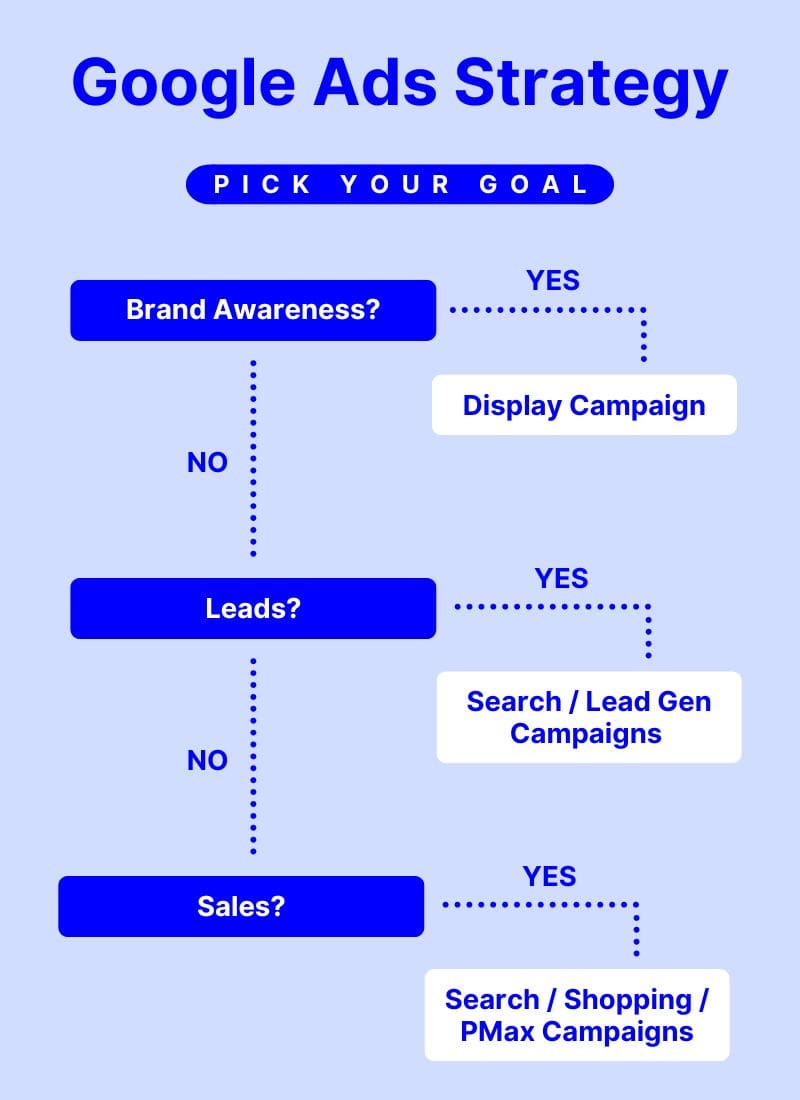Why Google Ads Keyword Research Matters in 2025
Google Ads is more competitive than ever, and the key to success is proper keyword research. Without it, you risk wasting your budget on irrelevant clicks and missing high-value opportunities. By following a structured research process, you can uncover profitable keywords, target the right audience, and optimize ad performance to maximize ROI.
This guide will walk you through everything you need to know about Google Ads keyword research and strategy in 2025.
Step 1: Defining Your Advertising Goals
Before diving into keyword research and audience targeting, clearly define your campaign objectives. Ask yourself:
-
Are you aiming for brand awareness, lead generation, or direct sales?
-
Do you want to drive website traffic or increase conversion rates?
-
What budget constraints do you have for your campaign?
Your answers will determine your approach, including keyword selection, audience targeting, and bidding strategies. Have a look at the simplified diagram below to get a starting point.
Step 2: Understanding Google’s Shift to Intent-Based Keyword Targeting
Google Ads has shifted from strict keyword matching to intent-based targeting. This means Google focuses on the meaning behind searches rather than just exact keywords.
- Search queries are more conversational, often influenced by AI and voice search.
- Exact match and broad match keywords are now more effective than phrase match.
- Google uses machine learning to match search intent more accurately.
Google Ads Keyword Match Types in 2025
- Exact Match (Recommended for Precision)
- Matches searches with the same intent, not just exact wording.
- Example: “furniture store” may also match “home furnishing shop”.
- Broad Match (Recommended for Discovery)
- Expands targeting to related search terms.
- Example: “home decor shop” could match with “modern interior stores”.
- Phrase Match (Less Relevant in 2025)
- Previously allowed keyword order variations, but exact match now covers this functionality.
- Offers no major advantage over broad or exact match.
Best Practice:
Use a combination of broad match for discovery and exact match for control to maximize your campaign’s reach and precision.
Step 3: Conducting Keyword Research
Keyword research is the foundation of any Google Ads campaign. Here’s how to do it effectively:
1. Start with Core Keywords
Brainstorm 3-4 core keywords that represent your business. These should be:
- Highly relevant to your products/services.
- At least three to five words long (for broad match effectiveness).
- Focused on user intent rather than just individual words.
Example:
- “Modern home decor shop”
- “Luxury living room furniture”
- “Best wooden dining tables”
2. Use Google Keyword Planner
Navigate to Google Ads → Tools → Keyword Planner → Discover New Keywords:
- Enter your core keywords.
- Add your website URL to get keyword suggestions tailored to your business.
- Click “Get Results” to see search volumes, competition levels, and CPC estimates.
3. Analyze & Refine Your Keywords
When reviewing suggested keywords, focus on:
- Search Volume: Aim for steady or growing monthly searches.
- Competition Level: Low to medium competition keywords offer a better cost-per-click (CPC).
- Bid Estimates: Ensure CPC estimates fit within your budget.
Using our guide, discover what is a good CPC based on your industry.
4. Categorize Keywords by Intent
To maximize conversions, classify your keywords into three categories:
- Transactional (High Intent): Users ready to buy (e.g., “buy iPhone 15 online”).
- Navigational: Users looking for a specific brand or website (e.g., “Nike running shoes official site”).
- Informational: Users researching before purchasing (e.g., “best laptops under $1000”).
Prioritize transactional and high-intent keywords to drive more conversions.
5. Group Keywords into Campaigns & Ad Groups
Organize keywords based on themes:
- Each campaign should represent a broader category (e.g., “Luxury Furniture”).
- Each ad group should contain tightly related keywords (e.g., “Dining Room Sets”).
Example keyword grouping:
| Campaign | Ad Group | Keywords |
|---|---|---|
| Modern Furniture | Living Room | “Modern sofas”, “Luxury couches” |
| Modern Furniture | Dining Room | “Best dining tables”, “Elegant chairs” |
6. Exclude Irrelevant Keywords (Negative Keywords)
Identify and remove unrelated keywords that Google suggests to prevent wasted ad spend.
Example: If you sell “luxury watches,” exclude terms like “cheap watches” or “free watches.”
To learn more, read our article about How to Use Negative Keywords.
Step 4: Optimizing Your Google Ads Keyword Strategy
1. Regularly Update & Test Keywords
-
Google search behavior is constantly changing—15% of searches each day are new.
-
Monitor performance data weekly and adjust keyword lists accordingly.
2. Use Google’s Forecasting Tool
-
Access the Forecast feature in Keyword Planner to predict clicks, impressions, and costs.
-
Download data into Google Sheets to create a structured keyword plan.
3. Optimize for ROI
-
Remove high-cost, low-converting keywords.
-
Focus on keywords with strong conversion rates and high intent.
-
Adjust bids based on competition levels and conversion potential.
Step 5: Understanding Audience Targeting
Targeting the right audience ensures your ads reach potential buyers instead of random visitors.
1. Utilize Google’s Audience Segments
- In-Market Audiences: Users actively searching for products/services like yours.
- Custom Audiences: Build intent-based audiences from user behavior.
- Remarketing Audiences: Target users who visited your site but didn’t convert.
2. Leverage Demographic and Location Targeting
- Adjust bids based on age, gender, income level, and device usage.
- Use geo-targeting to focus on high-demand locations.
3. Exclude Irrelevant Audiences
- Use negative audience targeting to prevent wasted ad spend.
- Exclude users who already converted or showed low buying intent.
Step 6: Optimizing Your Bidding Strategy
1. Choose the Right Bidding Strategy
- Maximize Conversions: Best for conversion-driven campaigns.
- Target CPA (Cost Per Acquisition): Ensures cost control per conversion.
- Target ROAS (Return on Ad Spend): Maintains profitability.
- Manual CPC: Allows greater control over individual bid adjustments.
You can learn more about bidding strategies, the difference between Smart Bidding and Manual Bidding with our Bidding Strategies Guide.
2. Adjust Bids Based on Data
- Increase bids for high-converting locations, devices, and audience segments.
- Lower bids for low-performing keywords or placements.
3. Use Automated Rules and Scripts
- Set bid adjustments automatically based on performance thresholds.
- Use scripts to pause underperforming keywords and allocate budget efficiently.
Step 7: Tracking and Measuring Performance
1. Set Up Conversion Tracking
- Use Google Tag Manager and Google Analytics 4 to track purchases, sign-ups, and leads.
- Monitor conversion rates, cost per conversion, and ROAS.
We highly recommend Analytics Mania’s website for tracking and analytics guides.
2. Monitor Key Performance Metrics
- CTR (Click-Through Rate): Measures ad engagement.
- Quality Score: Higher scores reduce CPC.
- Impression Share: Measures visibility against competitors.
3. Regularly Optimize Your Campaigns
- Pause underperforming ads and reallocate budget.
- Refine targeting settings based on user behavior data.
- Continuously test new ad creatives and bidding strategies.
Conclusion
Keyword research is more than just picking words—it’s about understanding user intent, search behavior, and campaign structure. By following these updated strategies, you can ensure that your Google Ads campaigns in 2025 drive traffic and conversions efficiently.
Want more insights? Get a FREE 30 min consultation with one of our experts to learn how to improve your Google Ads.
Discover More Ultimate Guides
FAQ – Google Ads Keywords Strategy
How often should I update my Google Ads keyword list?
It’s best to review your keyword performance weekly and update your list at least once a month to align with search trends and eliminate underperforming keywords.
What is the best keyword match type to use in 2025?
A combination of broad match for discovery and exact match for control is recommended. Broad match helps you find new opportunities, while exact match ensures high relevance.
How can I reduce wasted ad spend in Google Ads?
Use negative keywords, refine audience targeting, and continuously analyze performance metrics to ensure you’re reaching the right audience.



